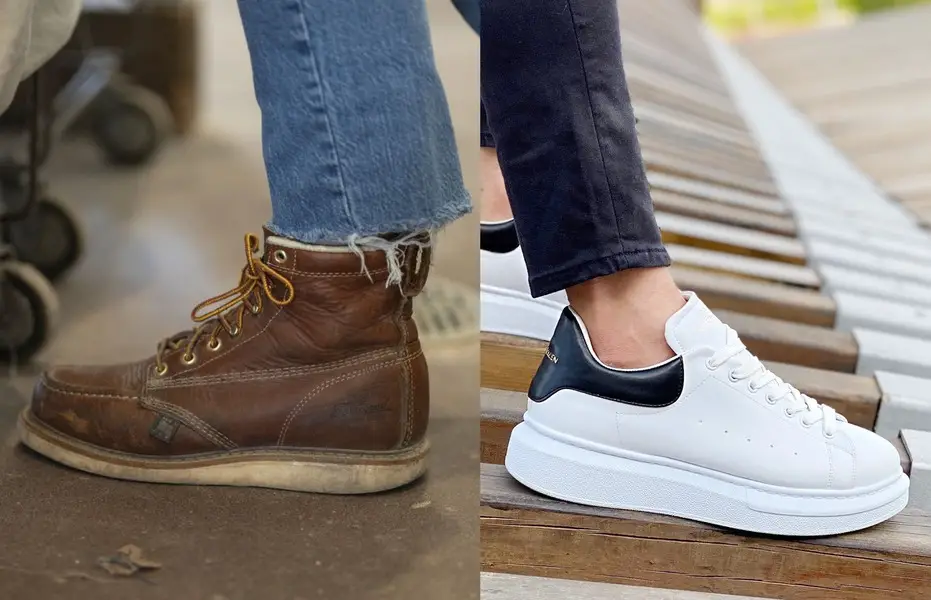Sneakers and work boots are both great in their own respective fields. But in a work environment, we cannot expect sneakers to protect you as much as a work boot.
It is because work boots are designed to keep your feet protected against any hazards. Whereas, sneakers are casual shoes that do not come with any safety features, but are comfortable and lightweight.
The primary distinction between boots and sneakers is that boots are sturdy, strong, and long-lasting, whereas sneakers are light and comfortable.
Boots are tough shoes that cover the feet and ankles, whereas sneakers are soft, light, and comfortable shoes that are ideal for sports and other physical activities.

What are work boots?
Boots are a type of sturdy footwear that covers the feet and ankles. They’re usually bigger and higher than regular shoes and sandals. Boots were traditionally made of leather or rubber, and the heel of most boots is distinct from the rest of the sole.
Work boot safety regulations require employees to wear safety footwear at all times. Leather uppers, non-skid soles, oil resistance, and impact and compression resistance are all required for work boots.
Work boots must be long-lasting, comfortable, and weather-resistant in order to protect your feet for months.
What are sneakers?
Sneakers are soft, light, and comfortable shoes that are ideal for sports and other physical activities. They provide the wearer with comfort and versatility. It means you can perform any type of work with complete confidence.
If you are going to do some strenuous exercise, you should wear sneakers. Aside from that, you can wear sneakers while participating in high-energy sports such as basketball, football, and baseball.
Sneakers protect your knees and ankles from injury, especially during gameplay. There is no other footwear that allows you to achieve stability like sneakers.
But given an option, work boots are a superior choice because of more safety options.
Reasons why work boots are better in a work environment
Let us give you reasons why work boots are better.
1.) Work boots last longer than sneakers.
Depending on your needs, getting work boots is the better option. Both are excellent for protection, but sneakers will wear out faster if used daily.
Sneakers are also not built to withstand weights like work boots, so your heel or arch will be bearing more weight than necessary in a sneaker.
And depending on how frequently you use either, the cost difference between buying another pair of sneakers and replacing your current shoes before they wear out may be equal.
2.) Work boots provide better traction and stability
Work boots can provide better traction and stability on slippery surfaces because they have a firm grip, whereas sneakers’ tread wears easily.
Because rubber soles are smooth, there is less chance of any material getting caught between your shoe and the ground if you wear snow boots. This leaves little room, if any, for materials to become stuck and potentially cause discomfort and injury.
3.) Protection from falling objects
When working in a crowded and fast-paced environment, it is critical that workers not only wear protective clothing, but also have their feet protected from potential injuries.
Moving and lifting heavy objects, such as in a construction site, carries the risk of items falling on workers’ feet. Workers can be kept safe by wearing safety shoes with reinforced toes.
4.) It improves posture and prevents muscle strain.
Work boots not only protect workers from falls or crush injuries, but they can also help to prevent muscle strain.
Boots that are well cushioned and support the arch of the foot provide a comfortable shoe that correctly aligns the leg, aiding in posture and reducing back pain.
5.) Supports in the prevention of electric shocks
Electricity is obviously a huge risk factor in many workplaces, and even if health and safety measures are in place, workers must wear the proper safety footwear.
To avoid receiving an electric shock, these should be made of non-conductive materials such as leather or rubber. If your employees work in an environment where static electricity is likely, anti-static footwear are also recommended.
But that doesn’t mean sneakers are anywhere behind when it comes to good features. They’re an excellent choice while running, hiking or any other physical activity.
Let us check some of the benefits of wearing sneakers.
Advantages of wearing sneakers
1.) Sneakers are more comfortable to wear throughout the day- It is true that sneakers are designed to be worn all day because they are lightweight and breathable and do not let your feet become sweaty and uncomfortable.
2.) It is comfortable and lightweight- Sneakers also allow the feet to breathe, which is important when you’re on your feet all day, sweating or in discomfort.
3.) Sneakers offer versatility- After comfort, another important feature to consider is versatility. It makes no difference what kind of work you do.
It is critical to wear shoes that are both versatile and comfortable. Casual sneakers are thought to be the best for running, walking, and doing workouts.
4.) Sneakers are breathable- Sweat begins to form under your shoes after performing strenuous exercises. Breathability is an important feature that contributes to the sneakers’ advantages.
It is advised to purchase sneakers made of breathable materials. Sweating on your feet will leave a foul odor, and cause skin infections.
Factors to consider when deciding whether you should go for work boots or sneakers.
The primary function of work boots is to protect the wearer’s feet while engaging in activities involving physical labor or exposure to the elements.
Sneakers, on the other hand, serve a more mundane purpose and were created with sports in mind. They may be less protective for outdoor use, especially in extreme conditions, but they usually provide more comfort and flexibility.
For most people, this means that sneakers are a better choice for everyday use than work boots, which is why we recommend prioritizing stability and comfort over protection as your primary consideration.
When deciding which type of shoe to buy, consider your budget, how frequently you will wear the shoes, what activities you will use them for, and how long they will last.
Sneakers are relatively inexpensive up front, so it costs less to repair or replace them later. They are sometimes less expensive than work boots because manufacturers sell far more sneakers than work boots.
Work Boots and Sneakers Comparison Table
| Parameters | Work boot | Sneakers |
| Material | Leather, rubber | Rubber, synthetics |
| Upper | Made of leather, and consists of a steel toe cap. | Made of leather or synthetics, does not contain a toe cap. |
| Sole | Leather and rubber | Rubber or PU soles |
| Weight | They are heavy, 3.5- 4.5 lbs approx. | It is lightweight, 1.7 lbs approx. |
| Comfort | Not apt for long hours. | They are comfortable. |
| Breathability | Okay | Excellent |
| Safety | Excellent | Okay |
| Traction | Excellent | Good |
| Durable | Very durable | Not as durable as a work boot. |
| Water resistant | Yes | Some of them |
| Cost | Expensive | Expensive |
FAQs-
What shoes are the most comfortable to wear for extended periods of time?
Because of the pressure against the entire calf, a work boot is designed to fit snugly around your leg, making it more comfortable for long periods of time.
A sneaker, on the other hand, leaves some space between your leg and the shoe, which may cause discomfort over time.
Is it better to wear boots to work than sneakers?
The truth is that it depends on the situation and your requirements. Here are the advantages and disadvantages of each- sneakers have more maneuverability, can be worn with dress clothes, and are less expensive than boots. However, they have more slippery soles and are not as protective as boots.
Boots have more protection from the elements and are more comfortable for those who are on their feet all day. If it’s more casual, you might want to wear sneakers, but if it’s more formal, you might want to wear boots.
Conclusion
You must understand which footwear will best protect your feet. The primary distinction between boots and sneakers is that boots are sturdy, strong, and long-lasting, whereas sneakers are light and comfortable.
Boots are typically larger and higher than sneakers, and they can be worn in all weather conditions, including heavy rain and snow.
When deciding whether to wear sneakers or work boots to your next job, there are several factors to consider and we have provided you enough information on both so that you make an informed decision.







